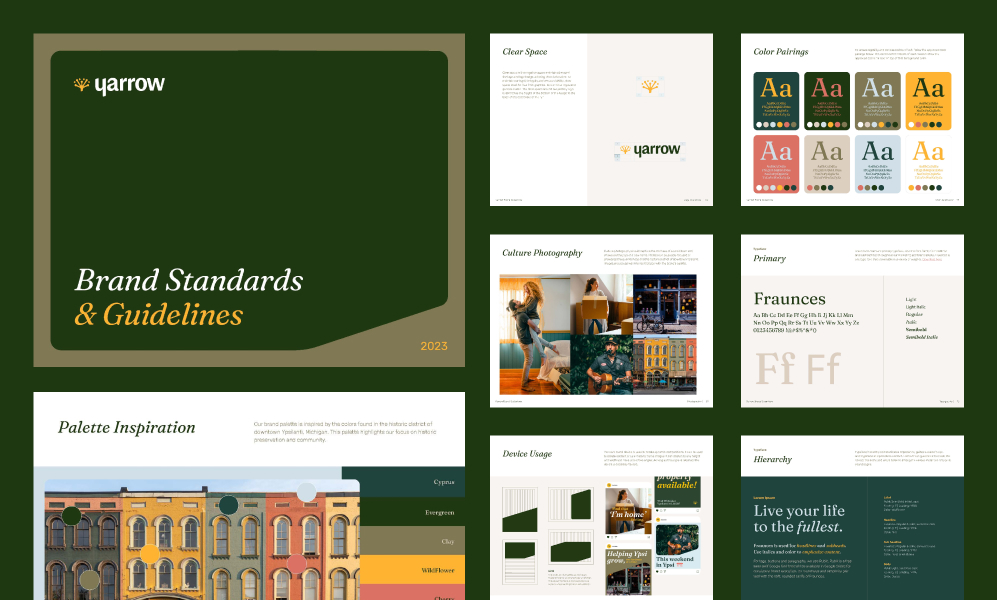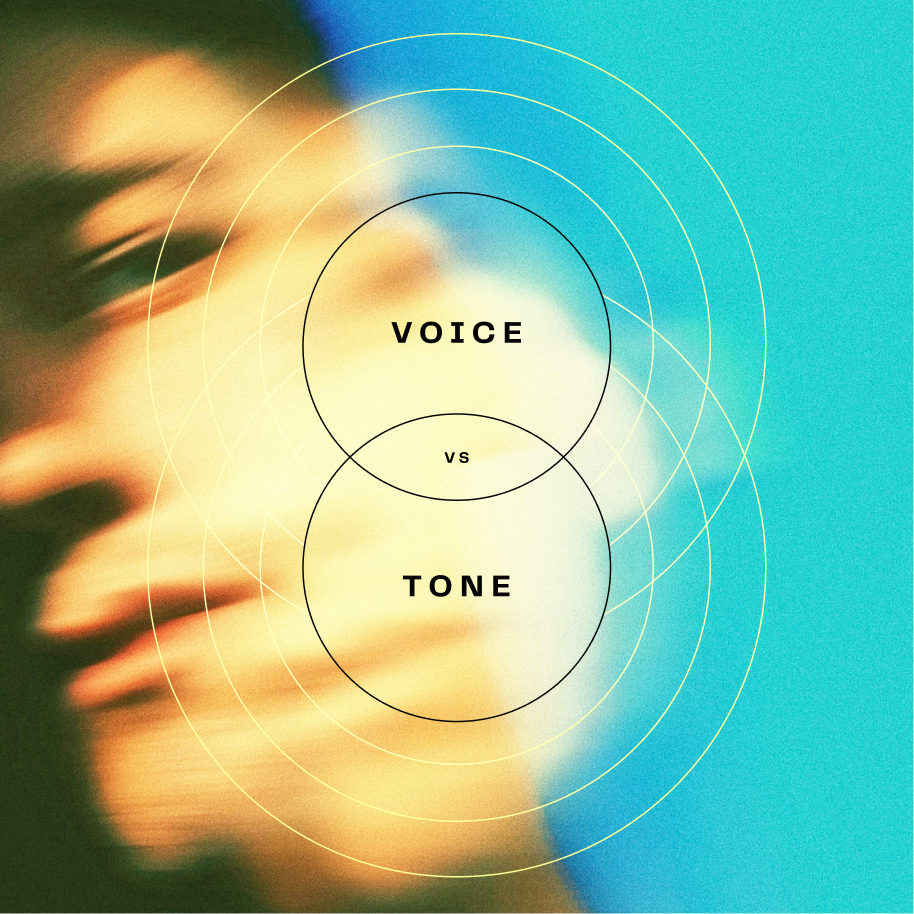Well-crafted brand guidelines form the bridge between a brand’s highest aspirations and its practical, real-world execution. As such, they serve as both a single source of truth and a user’s manual of sorts for how to communicate visually and verbally about an organization.
While each brand is unique and therefore needs its own custom guidelines, there are still some best practices that can prevent you from reinventing the wheel. In this guide, we cover the common elements that are often in play. While some guidelines may learn more heavily into visuals, others may need more in-depth guidance on verbal parameters. In any case, these are the major components to consider.
Who you are: foundational elements in brand guidelines.
To start, guidelines should bring together all the foundational elements of your brand. This can include:
- Mission
- Vision
- Values
- Positioning statement
- Messaging frameworks
- Narrative guidelines (i.e., how to tell your brand’s story)
- Audience personas
These crucial brand elements provide context and clarity, illuminating the why behind your visual and verbal expression. Unless these elements are included, even if in a condensed form, it can be easy to lose sight of the strategy and meaning behind your brand when it comes to creating materials.
What you say & how you say it: verbal identity in brand guidelines.
After the foundation is laid, you will likely want to move into covering your verbal identity. This typically provides a nice transition, since messaging is often covered in the first few pages.
Building on key messaging, more detailed verbal elements might include:
- How to use your organization’s name: Not every organization will require guidance here, but you might consider: Are there legal identifiers (e.g., trademarks or copyright symbols)? Is there a full, formal name used in a first instance? Are any abbreviations or informal names appropriate, and if so, in what applications? Are there any rules around capitalization or line breaks?
- Voice and tone descriptions: How does your brand communicate its value, character and personality? How does that voice modulate across channels and audiences?
- Preferred style guidelines: Indicate which third-party source of authority users should reference, such as The Associated Press Stylebook, The Chicago Manual of Style or whatever style guide is most appropriate for your industry. If there are any style rules that will be particularly helpful for your organization, such as a tricky nuance that often comes into play, or any notable exceptions to your selected third-party style guide, call them out here.
Codifying verbal guidelines is critical for maintaining a unified, distinct communication style that reflects the brand across channels and audiences. It’s a way to outline and preserve written brand personality and underscore key points of differentiation.
How you look (& how you don’t): visual identity in brand guidelines.
While some brand guidelines often — in our view, mistakenly — overlook the two areas above, they almost always cover visual identity in great detail. This is, of course, incredibly important, as visuals are the first thing most people see and remember.
Effective visual brand guidelines typically include:
- Logo rules, including dos and don’ts for stretching, reworking and placing logo variations over different backgrounds
- Color application, including the full palette, proportions and pairings
- Typography, including typefaces and hierarchies (i.e., size, weight, color, capitalization, etc.)
- Photography style, such as color or black/white, depth of field, focus, texture, lighting recommendations, subject placement and styling, tone and more
- Illustration style
- Iconography style
- Layout guidance
- Sub-branding rules, if applicable
- An ownable graphic device: This refers to some visual element — like a pattern, texture or shape — that can be amplified to create a more impactful, cohesive system. It is often (but not always) pulled from the logo. (See an example from Sunup’s own work, using intersecting line elements, here.)
A strong visual identity section in your brand guidelines will ensure every touch point ties together. It should provide detailed guidance on visual asset usage, enabling better design and protecting your brand’s equity.
How brand guidelines come to life: examples & templates.
As the saying goes, “Show, don’t tell.” In practice, effective brand guidelines do both.
That means developing brand guidelines in a way that your average colleague can understand and use — not just someone on the design or marketing team. The best brand guidelines consider this, showcasing brand-in-action samples that demonstrate how the verbal and visual identity system comes together. This may include showing mockups of:
- A website
- Your social media channels
- Slide decks
- Swag, such as T-shirts and mugs
- Digital and print ads
- Business cards
- Signage
… and much more.
You might also consider adding linked or shareable templates within your guidelines document, giving people easy access to the files they’ll need most often (such as presentation decks and letterhead). Remember, the harder it is for people to find something, the more likely they are to go rogue.
Looking ahead: adaptive to new platforms.
A few words about brand guidelines in 2024 and beyond: In the digital era, brands interact with their customers through websites, apps, social media, push notifications and more. Modern brand guidelines — and modern brands, for that matter — account for the many ways we communicate now and are flexible enough to accommodate evolving platforms while maintaining brand integrity, ensuring a seamless brand experience.
As an extension of this, you might consider creating your brand guidelines in a digital or web-based format. Of course, the exact format is far less important than what’s most readily available for most people at your organization, and often a PDF in a shared folder is preferred.
Examples of effective brand guidelines.
Now that you know the common components and potential formats of brand guidelines, you might be looking for some inspiration. To help, here are some publicly available brand guidelines that we admire:
- Mailchimp, particularly for its voice and tone rules
- Slack, particularly for its organization, simplicity and easy navigation
- IBM for being thorough and thoughtful
- Shopify, while not as sleek as some, for its detailed and helpful examples of voice and tone for different UX scenarios
- Urban Outfitters for being unabashed about its brand essence, up to and including a clear definition of its target audience. This brand, and these guidelines as an expression of it, won’t be to everyone’s taste. And that’s the point.

Keep your brand guidelines actionable.
Brand guidelines are only as good as they are useful. As such, they need to be easy to understand and contain only the information that will give people enough context and direction to execute brand assets. No more, no less.
Guidelines are not the place to get overly cerebral or detailed (unless that fits your brand). So ask yourself: Do we really need a treatise on the intricacies of our typeface or a manifesto on the meaning of our name? Save it for your blog! 😉
In other words, use the same good judgment and best practices you would for any other marketing material. Edit. Be clear. Give enough guidance to be helpful, but not so much that it’s overwhelming or hard to parse. Know your audience. And know how they’ll be most likely to use your brand guidelines so you can house them somewhere that’s easily accessible.
If you’re looking for help and need a team of experts — who have collectively created enough brand guidelines to circle the earth twice — get in touch today.



